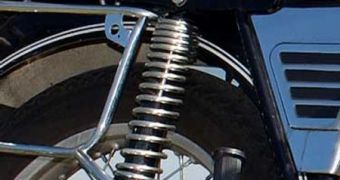The Massachusetts Institute of Technology boasts again a groundbreaking achievement, announcing that some of its students have managed to create a brand new class of vehicle shock absorbers, one that is also capable of producing electricity every time the car, truck, or motorcycle drives over a bump in the road. Their idea is fairly simple – tap into the power that each of these bumps generates in the suspensions of the car, and specifically in the shock absorbers.
At the beginning of the project, the science team was determined to find a good way of harnessing electrical power from cars, seeing how more current would mean increased ranges and battery power, especially for hybrids and all-electric cars. Seeing how tapping into the energy released by breaking had already been done before, they quickly settled on the suspensions as the next best thing.
Inside the specially-designed shock absorbers they constructed, they placed a small turbine, which was driven by the downward and upward movement of the fluid inside the devices. The turbine is naturally hooked up to a small generator, which produces the electrical current. In order to test their devices, the students rented numerous vehicles of all categories, attached sensors to their suspensions, and started driving around, taking note of the reads they got.
According to the scientists, a large amount of potential energy is lost in conventional suspensions, but this is where the new shock absorbers step in. They work effectively in producing current, but also smoothen the ride altogether, on account of the fact that an electrical mechanism regulates the movement of the turbine, thus slowing or accelerating the motion of the fluids inside the shock absorbers.
The students even formed a company, Levant Power Corp., and applied for patent last year. They already got some positive feedback from the US Army, as well as from several large truck manufacturers. The system naturally works best for large vehicles, considering the fact that the amount of electricity produced increases with the size of the absorber, and the amount of fluid inside it.

 14 DAY TRIAL //
14 DAY TRIAL //